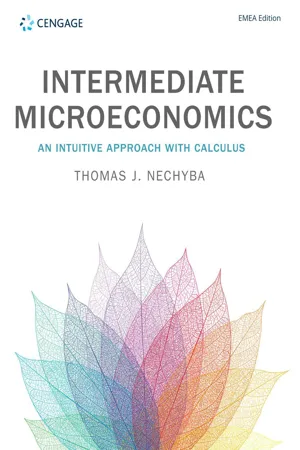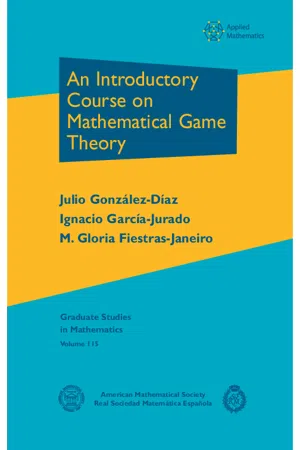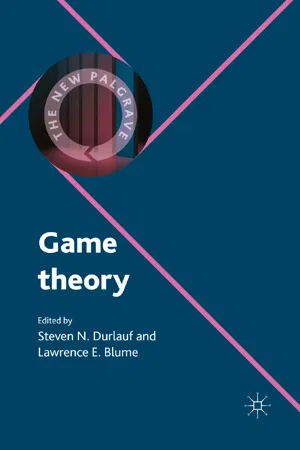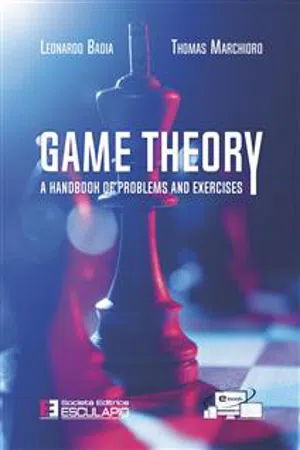Economics
Sequential Games
Sequential games are a type of game theory where players make decisions in a specific order, knowing the actions of those who have already chosen. This sequential decision-making process can lead to different outcomes than simultaneous games, as players can anticipate and react to each other's moves. Understanding the sequence of actions and potential reactions is crucial in analyzing and strategizing in sequential games.
Written by Perlego with AI-assistance
Related key terms
1 of 5
9 Key excerpts on "Sequential Games"
- eBook - PDF
- Shaheen Fatima, Sarit Kraus, Michael Wooldridge(Authors)
- 2014(Publication Date)
- Cambridge University Press(Publisher)
3 Games in extensive form While normal-form games capture the strategic structure of decision-making settings, they abstract away one key aspect of playing games that seems quite central to their character. Specifically, they assume that players make choices and act simultaneously, with no knowledge of the choices of their counterparts. But in many strategic situations, the players do not move simultaneously: they take turns in making their moves. An obvious example of such a situation is the game of chess. Another example is a bargaining scenario where a buyer and a seller take turns in making offers to each other in order to reach an agreement on the price of a commodity. Such situations may be modelled using sequential-moves games. In this chapter, we will study how these games are represented, and what notions of equilibria are used to analyse and solve them. In a purely sequential-moves game, the players not only take turns in mak- ing their moves, but they typically know what the players did in all the previ- ous moves. In contrast, when a player makes a move in a simultaneous-moves game, he does not know the other players’ moves. Purely sequential-moves and purely simultaneous-moves situations rarely arise in practice; many interesting real-world situations involve both simulta- neous and sequential moves. Thus, we will learn how to model such situations with games and how to analyse and solve those games. Strategic situations with sequential moves are typically represented as games in extensive form. A game in extensive form is specified in terms of a set of players, when each player in the game is allowed to move, the information each player has about the sequence of previous moves, information about random events such as nature (these random events are generally referred to as chance or nature moves), and the utility functions of the players. - eBook - PDF
Intermediate Microeconomics
An Intuitive Approach with Calculus
- Thomas Nechyba(Author)
- 2018(Publication Date)
- Cengage Learning EMEA(Publisher)
Cengage Learning reserves the right to remove additional content at any time if subsequent rights restrictions require it. 720 CHAPTER 24 STRATEGIC THINKING AND GAME THEORY 24A.1.2 Sequence of Actions A further feature of a game involves the sequencing of moves by the differ-ent players. In some cases, we might model an economic situation as one where all players have to decide what action to take simultaneously , while in other cases we might model a situation where some players will make sequential moves, with the actions of players who move early observable to the players who de-cide on their actions later on. The first is a simultaneous move game , while the second is a sequential move game . For instance, as two fuel station owners on opposite sides of a street come to work in the morning, they might face a simultaneous choice of what price to post as rush hour traffic is about to start. Alterna-tively, one fuel station owner might show up half an hour later to work, in which case they might be able to observe what their competitor has posted prior to deciding what they will post. Players in a game are defined not only by the set of actions they have available to choose from but also by whether or not they are able to observe the other players’ moves prior to determining their own. 24A.1.3 The Payoff Matrix for a Simultaneous Move Game Once we have defined the set of possible actions and the sequence of moves for the relevant players in a game, we have to settle on what the conse-quences of different combinations of actions will be for each player. These consequences are referred to as payoffs , and the payoff for player n may depend on both their own action as well as the action(s) taken by others. the worker has the option of accepting or rejecting the offer, resulting in A e 5 { High Wage, Low Wage } and A w 5 { Accept, Reject }. - eBook - PDF
Independence-Friendly Logic
A Game-Theoretic Approach
- Allen L. Mann, Gabriel Sandu, Merlijn Sevenster(Authors)
- 2011(Publication Date)
- Cambridge University Press(Publisher)
2 Game theory According to A Course in Game Theory, “a game is a description of strategic interaction that includes the constraints on the actions that the players can take and the players’ interests, but does not specify the actions that the players do take” [45, p. 2]. Classical game theory makes a distinction between strategic and extensive games. In a strategic game each player moves only once, and all the players move simultaneously. Strategic games model situations in which each player must decide his or her course of action once and for all, without being informed of the decisions of the other players. In an extensive game, the players take turns making their moves one after the other. Hence a player may con- sider what has already happened during the course of the game when deciding how to move. We will use both strategic and extensive games in this book, but we consider extensive games first because how to determine whether a first- order sentence is true or false in a given structure can be nicely modeled by an extensive game. It is not necessary to finish the present chapter before proceeding. After reading the section on extensive games, you may skip ahead to Chapter 3. The material on strategic games will not be needed until Chapter 7. 2.1 Extensive games In an extensive game, the players may or may not be fully aware of the moves made by themselves or their opponents leading up to the current position. When a player knows everything that has happened in the game up till now, we say that he or she has perfect information. In the present section we focus on extensive games in which the players always 10 Game theory have perfect information, drawing heavily on the framework found in Osborne and Rubinstein’s classic textbook [45]. 2.1.1 Extensive games with perfect information Definition 2.1 An extensive game form with perfect information has the following components: • N , a set of players . • H, a set of finite sequences called histories or plays . - Julio González-Díaz, Ignacio García-Jurado, M. Gloria Fiestras-Janeiro(Authors)
- 2010(Publication Date)
- American Mathematical Society(Publisher)
Chapter 2 Strategic Games 2.1. Introduction to Strategic Games A strategic game is a static model that describes interactive situations among several players. 1 According to this model, all the players make their deci-sions simultaneously and independently. From the mathematical perspec-tive, strategic games are very simple objects. They are characterized by the strategies available to the players along with their payoff functions. Even though one may think of the payoffs of the players as money, we have al-ready seen in Chapter 1 that payoff functions may be representations of more general preferences of the players over the set of possible outcomes. These general preferences may account for other sources of utility such as unselfishness, solidarity, or personal affinities. Throughout this book it is implicitly assumed that each player is ratio-nal in the sense that he tries to maximize his own payoff. Moreover, for a rational player, there is no bound in the complexity of the computations he can make or in the sophistication of his strategies. 2 We start this chapter by formally introducing the concept of strategic game and then we move to the most widely studied solution concept in game theory: Nash equilibrium. We discuss some important classes of games, with special emphasis on zero-sum games. Later we study other so-lution concepts different from Nash equilibrium (Section 2.9) and, towards 1 Strategic games are also known as games in normal form . 2 This assumption is standard in classic game theory and in most of the fields in which it is applied, especially in economics. Rubinstein (1998) offers a deep treatment of different directions in which the rationality of the agents can be bounded along with the corresponding implications. 13 14 2. Strategic Games the end of the chapter, we try to establish a bridge between equilibrium behavior and rational behavior (Section 2.12). We denote the set of players of a game by N : = { 1, .- eBook - PDF
- Steven N. Durlauf, Lawrence E. Blume, Steven Durlauf(Authors)
- 2016(Publication Date)
- Palgrave Macmillan(Publisher)
strategic and extensive form games 1. Introduction Game theory is a collection of models designed to understand situations in which decision-makers interact. This article discusses models that focus on the behaviour of individual decision-makers. These models are sometimes called ‘non-cooperative’. 2. Strategic games 2.1 Definition The basic model of decision-making by a single agent consists of a set of possible actions and a preference relation over this set. The simplest theory of the agent’s behaviour is that she chooses a member of the set that is best according to the preference relation. The model of a strategic game extends this model to many agents, who are referred to as players. Each player has a set of possible actions and a preference relation over action profiles (lists of actions, one for each player). Definition 1 A strategic game with deterministic preferences consists of a set N (the set of players) and for each player i 2 N a set A i (the set of player i’s possible actions) a preference relation h i over the set j2N A j of action profiles. A strategic game hN; ðA i Þ; ðh i Þi is finite if the set N of players and the set A i of actions of each player i are finite. The fact that each player’s preferences are defined over the set of action profiles allows for the possibility that each player cares not only about her own action but also about the other players’ actions, distinguishing the model from a collection of independent single-agent decision problems. Notice that the model does not have a temporal dimension. An assumption implicit in the solution notions applied to a game is that each player independently commits to an action before knowing the action chosen by any other player. Notice also that no structure is imposed on the players’ sets of actions. - Leonardo Badia, Thomas Marchioro(Authors)
- 2022(Publication Date)
- Società Editrice Esculapio(Publisher)
3 Sequential Games Sequential Games with perfect information are a particular class of dynamic games . 3.1 Characteristics In Sequential Games of n stages, players alternate in making their moves, that is, player 1 moves alone at stage 1 , then at subsequent stages j = 2 , 3 , . . . , n , it is player j = 2 , 3 , . . . , n ’s turn to move. In the case of perfect information, the player moves being informed about the choices made within all the previous j -1 stages. This last element is key to understand the game: all moves are made with full awareness of the previous choices. Clearly, all players see the evolution of the game in its entirety, but this assumption of perfect information is actually only relevant to the players to move, since the players are also generally assumed to have perfect recall, so they do not forget past moves. Also, it is equally importantly assumed that all the players are rational and this information is common knowledge among the players. Because of the properties mentioned above of the clearly specified order of moves and full information about the past history of the game, in a sequential game with perfect information the information set of each node is a singleton, which means that, when the gameplay dynamically evolves to a certain in-game situation, all the players (and most notably, the player to move) are perfectly informed about where the game is at. Thus, a sequential game is generally represented in extensive form by a plain tree without any possible confusion of the players to move; in other words, there are no dashed lines joining separate nodes of the tree. The extensive form may be preferred because it preserves the dynamic character of the game.- Walter Nicholson, Christopher Snyder(Authors)
- 2021(Publication Date)
- Cengage Learning EMEA(Publisher)
Editorial review has deemed that any suppressed content does not materially affect the overall learning experience. Cengage Learning reserves the right to remove additional content at any time if subsequent rights restrictions require it. 192 PART 3 ● Uncertainty and Strategy to prospective employers. We will study screening games, which include the design of deduct-ible policies by insurance companies in order to deter high-risk consumers from purchasing. As mentioned, auctions and card games also fall in the realm of games of incomplete information. Such games are at the forefront of current research in game theory. SUMMARY This chapter provided an overview of game theory. Game theory provides an organized way of understanding decision making in strategic environments. We introduced the follow-ing broad ideas: ● The basic building blocks of all games are players, ac-tions, payoffs, and information. ● The Nash equilibrium is the most widely used equilib-rium concept. Strategies form a Nash equilibrium if all players’ strategies are best responses to each other. All games have at least one Nash equilibrium. Sometimes the Nash equilibrium is in mixed strategies, which we learned how to compute. Some games have multiple Nash equilibria, and it may be difficult in these cases to make predictions about which one will end up being played. ● We studied several classic games, including the Prison-ers’ Dilemma, Matching Pennies, and Group Science Project (which is a variant of the better-known Battle of the Sexes). These games each demonstrated impor-tant principles. Many strategic situations can be distilled down to one of these games. ● Sequential Games introduce the possibility of contingent strategies for the second mover and often expand the set of Nash equilibria. Subgame-perfect equilibrium rules out outcomes involving empty threats. One can easily solve for subgame-perfect equilibrium using backward induction.- eBook - PDF
Game Theory
An Introduction
- E. N. Barron(Author)
- 2024(Publication Date)
- Wiley(Publisher)
The converse is not necessarily true. Behavior strategies will arise again when we calculate sequential equilibria for Bayesian games. Problems 3.16 Consider the following game in extensive form depicted in the figure 160 3 Games in Extensive Form: Sequential Decision Making 1:1 1:2 1:3 d u d u d u U 1 –1 –1 1 –1 1 –1 1 –1 1 D U D 2:1 2:2 1 2 1 2 (a) Find the strategic form of the game. (b) Find all the Nash equilibria. (c) Find the subgame perfect equilibrium using backward induction. 3.17 BAT (British American Tobacco) is thinking of entering a market to sell cigarettes currently dominated by PM (Phillip Morris). PM knows about this and can choose to either be passive and give up market share, or be tough and try to prevent BAT from gaining any market share. BAT knows that PM can do this and then must make a decision of whether to fight back, enter the market but act passively, or just stay out entirely. Here’s the tree: 1:1 1:3 1:2 Enter 2:1 Tough Tough Out Passive Passive Tough Passive Out Out 6 0 5 –2 2 –4 4 –2 –3 3 2 –4 –2 1 Find the subgame perfect Nash equilibrium. Problems 161 3.18 In a certain card game, player 1 holds two Kings and one Ace. He discards one card, lays the other two face down on the table, and announces either 2 Kings or Ace King. Ace King is a better hand than 2 Kings. Player 2 must either Fold or Bet on player 1’s announcement. The hand is then shown and the payoffs are as follows: 1. if player 1 announces the hand truthfully and player 2 Folds, player 1 wins $1 from player 2; 2. if player 1 lies that the hand is better than it is and player 2 Folds, player 1 wins $2 from player 2; 3. if player 1 lies that the hand is worse than it is and player 2 Folds, player 2 wins $2 from player 1; 4. if player 2 Bets player 1 is lying and if player 1 is actually lying the above payoffs are doubled and reversed. If player 1 is not lying, player 1 wins $2 from player 2. - R. Sugden(Author)
- 2004(Publication Date)
- Palgrave Macmillan(Publisher)
In most board games, players move in turn. In chess, for example, Black does not have to choose his first move until he has seen White’s. The same is true in many real-life games of social interaction. Suppose Arthur would like Bert to help him with some job on Monday, and Bert would like Arthur to help him with a different job on Tuesday. Arthur can wait to see whether Bert helps him before deciding whether to help Bert. At first sight, these games look very different from the banknote game. The truth, how- ever, is that games that involve a sequence of moves can be represented as though each player independently chooses a single strategy, cover- ing every possible contingency. Part of Black’s strategy for a chess game might be: ‘If White opens with P-K4, reply with P-QB4.’ Arthur’s strategy might be: ‘If Bert helps on Monday, help him on Tuesday; if he doesn’t help on Monday, don’t help him on Tuesday.’ It must be admitted that the list of strategies open to a player can be very long indeed, even in quite simple games. (If every chess game came 12 The Economics of Rights, Co-operation and Welfare to an end after Black’s first move, White would have 20 possible strategies and Black would have 20 20 – that is, more than 100 million billion bil- lion!) Obviously, then, there are many games for which it is impractical to list strategies. There may be other reasons for choosing to represent games in ways that make more explicit the order in which the players move. None the less, lists of strategies are always theoretically possible: the idea of such a list always makes sense. In other words, there is nothing logically contradictory about representing a game of sequential moves in terms of simultaneously-chosen strategies. In the banknote game the players are not allowed to communicate with one another. This makes it impossible for them to co-operate when choosing their strategies.
Index pages curate the most relevant extracts from our library of academic textbooks. They’ve been created using an in-house natural language model (NLM), each adding context and meaning to key research topics.








